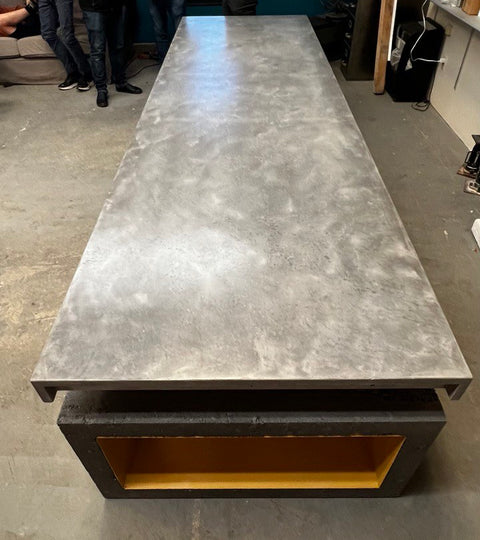Exploring the Benefits of Post-Tensioned Concrete Tables: A Guide to Design and Construction
Introduction:
Concrete is a versatile and durable material widely used in construction. In recent years, post-tensioning techniques have gained popularity due to their ability to enhance the structural integrity and longevity of concrete elements. In this blog, we will delve into the fascinating world of post-tensioned concrete tables, specifically focusing on a 12' long table with a 4" thickness. We will explore the advantages, design considerations, and construction process of such tables, drawing insights from educative papers to provide a comprehensive understanding of this innovative construction technique.
Advantages of Post-Tensioned Concrete Tables:
Post-tensioning offers numerous benefits over traditional reinforced concrete in the context of table construction. By introducing high-strength steel tendons into the concrete, post-tensioning can actively counteract tensile forces, significantly increasing the overall strength and durability of the structure. Some key advantages of post-tensioned concrete tables include:
Enhanced Load Capacity: Post-tensioning allows for thinner and lighter concrete sections while maintaining high load-bearing capacities, making it an ideal choice for longer spans and larger tabletops.
Increased Crack Control: The introduction of post-tensioning helps minimize cracking, as the prestressing forces compress the concrete, preventing the propagation of cracks.
Improved Deflection Control: Post-tensioning mitigates the deflection of the table, enhancing its performance and reducing long-term maintenance requirements.
Design Flexibility: Post-tensioned concrete tables offer greater design flexibility, enabling architects and engineers to create unique and aesthetically pleasing shapes, curvatures, and cantilevers.
Longer Lifespan: By reducing the effects of shrinkage, creep, and external loads, post-tensioning prolongs the lifespan of the table, ensuring its functionality for years to come.
Design Considerations (Approximately 150 words)
Designing a post-tensioned concrete table involves careful considerations to ensure structural efficiency and long-term performance. Educative papers such as "Design of Post-Tensioned Concrete Structures" by A. Scanlon and "Post-Tensioned Concrete Design" by H. B. Manish have provided valuable insights in this regard. Here are some essential design considerations for a 12' long, 4" thick post-tensioned concrete table:

Material Selection: Choose high-quality concrete and high-strength, low-relaxation steel tendons to meet the required design criteria.
Pre-stressing Layout: Determine the optimal tendon arrangement and profiles to distribute forces uniformly and minimize structural deformations.
Stressing Sequence: Develop a proper sequence for stressing the tendons to control concrete cracking and ensure uniform load transfer.
Anchorage System: Select appropriate anchorage systems based on the specific project requirements and ensure their compatibility with the concrete strength and tendon type.
Long-Term Durability: Consider corrosion protection measures for the tendons and design appropriate joint details to prevent water ingress and subsequent deterioration.
Construction Process
The construction of a post-tensioned concrete table requires careful planning and execution. Referencing educative papers such as "Construction of Post-Tensioned Structures" by P. Evans and "Practical Guide to Post-Tensioned Concrete Design and Construction" by D. Darwin can provide valuable guidance. Here is a general outline of the construction process:
Formwork Preparation: Create the formwork to the desired shape and dimensions of the table, ensuring proper reinforcement placement.
Concrete Placement: Pour the concrete, ensuring adequate consolidation to eliminate voids and air pockets.
Conclusion:
Post-tensioned concrete tables offer a host of advantages in terms of strength, durability, and design flexibility. By incorporating high-strength steel tendons, these tables can withstand heavy loads, control cracking, and provide superior deflection control. Design considerations, such as material selection, pre-stressing layout, and anchorage systems, play a crucial role in ensuring the long-term performance of the table. During the construction process, attention to detail in formwork preparation, concrete placement, and post-tensioning procedures is essential. As evidenced by educative papers, post-tensioning techniques continue to evolve, enhancing the overall efficiency and reliability of concrete structures. Incorporating these principles into the design and construction of a post-tensioned concrete table will result in a durable, aesthetically pleasing, and long-lasting piece of furniture.s,


0 Comments
There are no comments yet. Be the first one to post one!